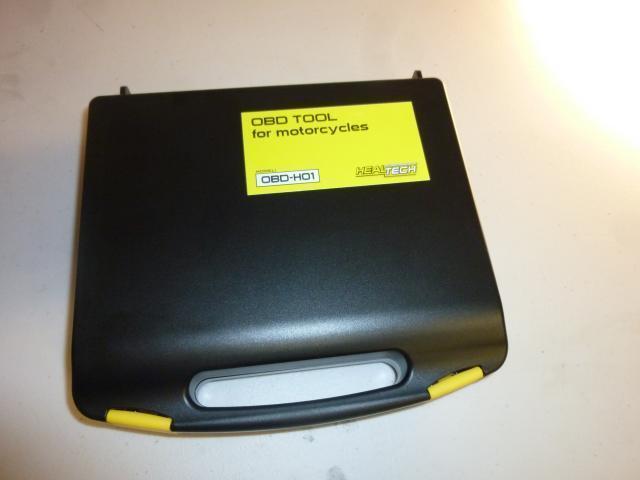-
Posts
1,317 -
Joined
-
Last visited
-
Days Won
12
Content Type
Forums
Profiles
Gallery
Blogs
Downloads
Events
Everything posted by kaldek
-
Don't forget that the one and only known example of a 6th-gen with bent valves was from a guy who fitted an APE tensioner. The lock nut loosened, and ka-boom. So while the stock OEM CCTs can be noisy, they don't tend to destroy engines.
-
Sounds like it's running super-duper rich. Have you owned a VFR before so you can compare this bike to previous experience (with regards to its power delivery)? When you did a "carb clean", what did that include?
-
Day job my ass, can be done in two hours (assuming you're used to tearing bikes apart). My video doesn't show assembly, but essentially installation is the reversal of removal. To get the throttle body back onto the boots it's a good idea to use a rubber safe lubricant like WD-40 on the boots. Then you use a rubber mallet to thump the whole assembly down onto the front boots first, then the rear boots.
-
I can't see the damage in that picture, but good to hear it was what we all thought!
-
No the VFRness won't fix those wires there. They need fixing up, but it's such a low res image I can't tell what I'm looking at - the main fuel cut relay perhaps?
-
PCV is unlikely to be the cause. It gets its power from the injector 12 volt feed and has its own dedicated ground (which you probably hooked up to the battery). The circuit that leads to your left hand indicator has shorted. It's probably shorted to ground and to the right hand indicator feed. I'd suggest it's fried up under the dashboard assembly, but the wiring there is a bit trickier than mine because the USA bikes have running lights (which requires a bunch of diodes). Any start at the handlebar assembly first and work your way towards the indicator relay and output wires from there.
-
That is no evidence of a fried stator. I've got one that's black (previous owner blew up their engine) but it cranks out the juice. However since you have a new stator now, your issue could be your regulator. You seriously need a voltmeter as it will warn you when the system is about to fail.
-

Oil leak - don't know how serious - pics
kaldek replied to marriedman's topic in Maintenance Questions
Nah, it has an overflow pipe. If it fills up it will just spash onto the ground. The pipe is just below the reservoir lid. I've not heard of a VFR overflowing its coolant bottle - ever. -

Oil leak - don't know how serious - pics
kaldek replied to marriedman's topic in Maintenance Questions
LOL I'm a huge computer nerd too. But unlike a lot of nerds I guess I also love mechanical things. Nerds are good for working on wiring harnesses and fuel injection too; most guys here focus on machining and construction (hi Seb!) but I focus my energies on what makes the bike decide to squirt fuel and when to make it go bang. Mind you I can strip a bike down to the frame and rebuild it so I guess I have some mechanical ability. It's all self-taught too, starting in about 2001 when I first pulled the carbs off my VT250. -

Fuel light calibration?
kaldek replied to douglasthecook's topic in Third and Fourth Generation VFR's
Yep, if your bike is only fitted with a fuel light, bending the sensor float a bit helps. I wouldn't do it to a bike with a gauge, but that's just me. -

Oil leak - don't know how serious - pics
kaldek replied to marriedman's topic in Maintenance Questions
Dude, seriously? You want something to get mad at, choose things like bent valves or fried stators. Even if you *had* a mid oil leak - and I don't think you do - they can be fixed easily enough. Don't stress! -
As the Mythbusters say - "Well there's yer prahblem!". Your instrument cluster wiring is dodgy, simple as that. Could be bad grounds, corrosion creating an unintended ground circuit or power feed where there shouldn't be one, etc. You'll probably spot it as soon as you crack the thing open.
-
The guy is a total muppet and has no idea what the hell he's talking about. Regulator my ass. Anyway some carbie bikes do often have a vacuum hose on the fuel petcock as a safety valve to stop fuel entering the carbs when the motor is off (in case the floats are stuck open). The 4th-gen doesn't have one as best I can tell from the parts fiche.
-
6th-gen COPs are three-wire plugs. They remain permanently fed by a common 12 volt source and the ECU sends a trigger command to the coil which causes it to charge up and then fire. The "ignition control module" is inside the coil, so there is no risk of the coil drawing too much current and damaging the ECU; it can only damage itself (the primary windings and transistor). I suppose the real question is - how does the trigger circuit work and could it be connected to the 4th-gen ignition module? I don't know enough to say why it would be possible or impossible.
-
Twenty-two.....tons.
-
I would expect a closed loop system to trim down the pulse length. That's assuming it's truly closed loop. There is no Long Term Fuel Trim (LTFT), only Short Term Fuel Trim (STFT) which only kicks in at certain situations. Finding exactly when those are is one of my main tests to perform, so I should know in a couple of weeks.
-

It doesn't really do it all, after all
kaldek replied to Hvrnaut's topic in Seventh Generation VFR's
Really, I wouldn't exactly say the 6th-gen is much better in that regard. Look at the 10 year old threads on Bikers Oracle about the snatchy throttle and the sudden bursts of power, and all the problems I've had over the years trying to sort it out. Mind you mine's pretty good now so I suppose it *is* possible to make the problems go away. But still, the point is the 6th-gen has the problem too. Maybe it's the same guy at Honda tuning engines the last 12 years and he's a total muppet when it comes to driveability tuning? -
Yeah pretty much, but like 1% of the price (or less).
-
-
Wouldn't do anything to the pulse width, the pulse time would be the same it would just deliver more fuel due to the higher pressure.
-
The OBD tool arrived today. Nice piece of kit! Now I just need to plan out some tests I want to run, which include: When the airbox flapper opens When the PAIR valve closes If the PAIR valve activation is linked to the O2 sensors.
-
Like everyone else has said, get a voltmeter. The first sign of a dud stator is that it puts out low voltage at idle when hot, and then it starts to stop putting out decent voltage until 3,000rpm. And then one day it just goes dead. Suddenly. Mine did that while I was synchronising the throttle bodies and idling the motor. What basically happens with them is that the insulation on the wiring degrades due to heat. When it degrades, it short circuits the winding and when that happens a winding which may have been, I dunno, 100 feet long is suddenly 1 foot long. Ergo, no energy created when a magnetic field (the rotor magnet) goes past. You can rewire a stator, but it's a bitch of a job and you need to make sure you use the correct type of wire with the right kind of insulation, and then you have to cover all that in heat resistant epoxy. Not for the feint of heart! Also as has been said, it's better to draw more current out of your stator than to not. This is because the less power taken from it, the more the regulator shunts the power the stator generates back into itself. This causes heat, which causes insulation to degrade faster.
-
-
I remember sitting behind a mate on an RC-51 with Akrapovic pipes one day. I swear I could have put my whole arm down there (and the sound pulses caused my chest to vibrate). Phat, PHAT sound. The straighter and more open, the better!



